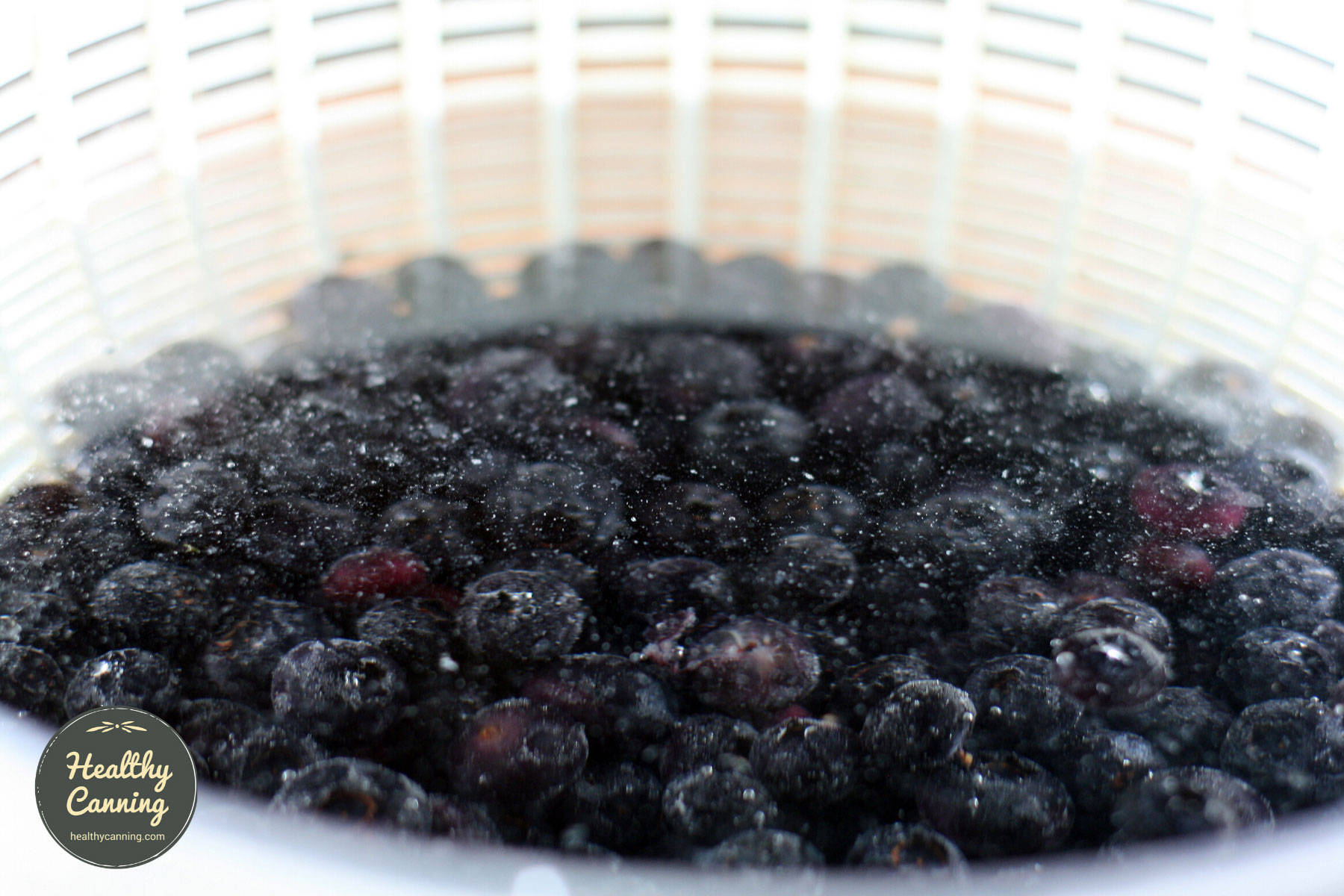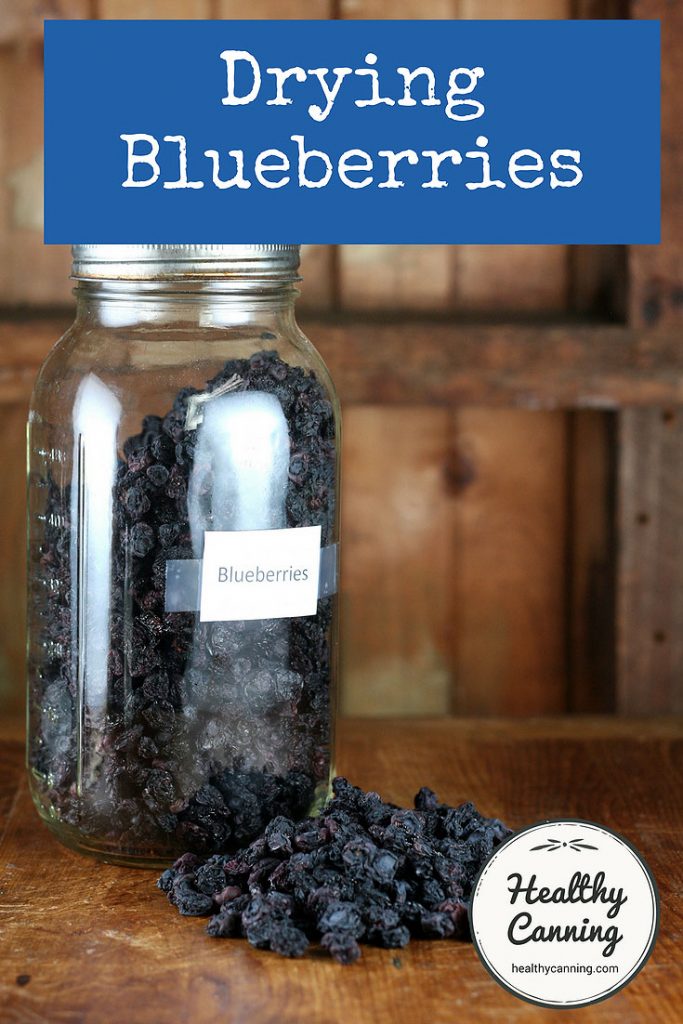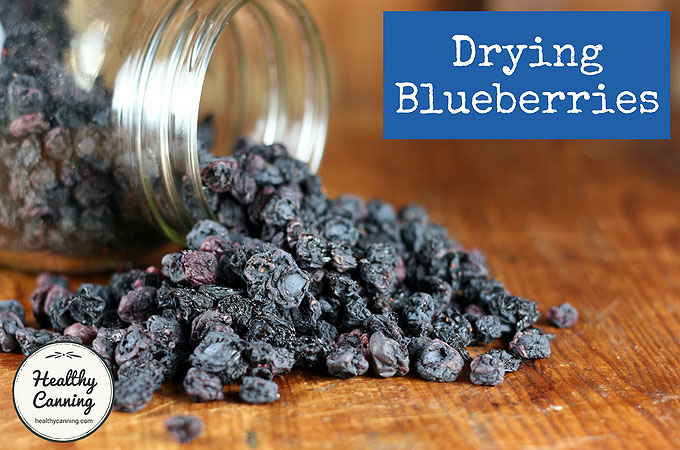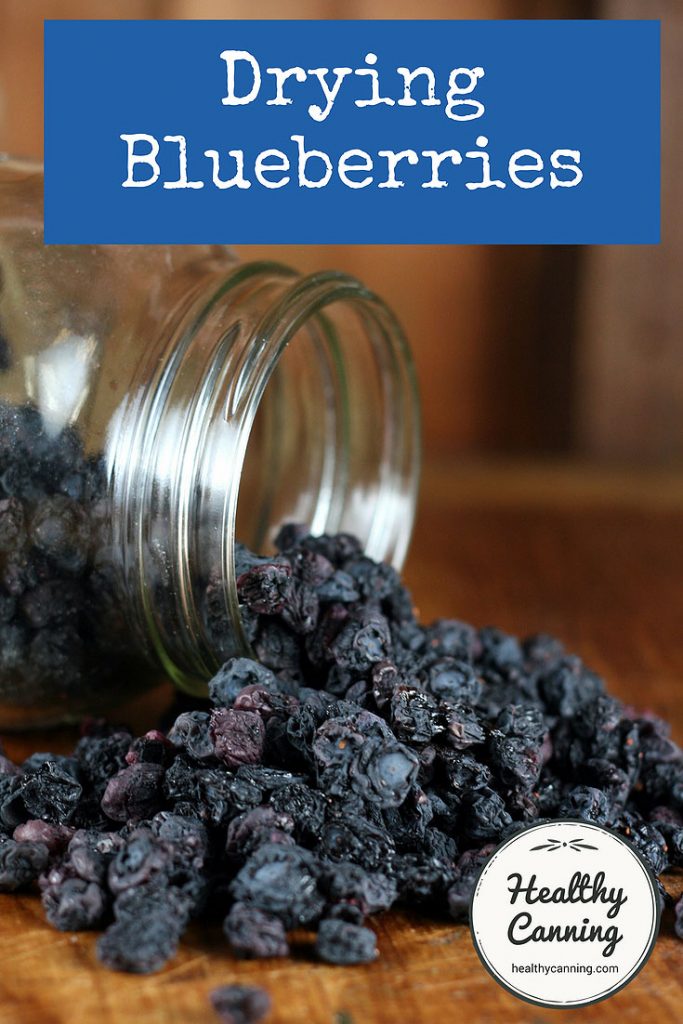Dried blueberries are a bit of work to make, in that they do require a brief blanching first, but otherwise are a very straightforward food to dry and yield a very satisfying and useful dried product.
They look like dried raisins at first blush. You could even call them “blaisins.” In fact you may actually do so: it seems someone even tried to trademark that word but gave up.
See also: Canning plain blueberries, Canning various blueberry jams and condiments
Yields and Equivalents
Per 1 kg (2.2 lbs / 1 ½ US quarts / 1 ½ litres) of fresh blueberries that you intend to dry, you will need 1 ½ Excalibator square dehydrator trays
5.5 kg fresh blueberries (12.5 lbs / 8 US quarts volume / 8 litres volume) = 9 Excalibur trays, blanched = 1 kg dried (2 ¼ lbs / 3 US quarts / 3 litres in volume)
1 kg fresh blue berries = 1.5 litres fresh blueberries in volume = 1 kg / 1 litre blanched and drained blueberries = 1 ½ dehydrator trays
1 kg fresh blueberries, avg 1.5 cm diameter = 1.5 litres in volume fresh
3 lbs fresh blueberries, avg .6 inches diameter = 2 US quarts in volume fresh
Before starting
A 9-tray Excalibur dehydrator can hold approximately 5 ½ kg (12 ½ lbs) of blueberries at one go.
Allow about 1 ½ hours to wash, blanch and tray that amount of blueberries, and clean up after.
Blanching blueberries
Blueberries have a waxy film on their skin, which can impede heat penetrating their interiors for efficient and even drying. Consequently they are “checked” before dehydrating: “checking” in this context means to make their surface “check – ered” with cracks. This is done by briefly blanching them which causes cracks in the waxy surface as the berry swells. The cracks allow the dehydrator’s heat into them more readily. An alternative which is sometimes suggested (though not a very appealing one) would be to pierce every single blueberry a few times with a pin.
This photo below shows just-blanched blueberries submerged in cold water to rapidly cool. You’ll notice the waxy film on the berries coming off and rising to the top of the water.

Waxy film on blueberries rising to top of cooling water after blanching
Directions
Here we compare directions from three different sources.
Ball Blue Book
Preparation: “Wash and remove stems.
Pretreatment: “Dip in boiling water 30 seconds to ‘check’ skins.”
Temperature: 130 to 135 F (54 to 57 C)
Time: Until leathery.
Notes: “Choose large, firm blueberries with deep-blue color… Blueberries dried without boiling first have a puffy appearance….”
Water content: 83%. (Used if doing a Dehydration Weight Test.)
Reference: Ball Blue Book, 37th edition, 2014. Page 164.
Note: Ball All New (2016) says “Choose large, firm berries. Wash and remove stems. Blanch for 30 seconds or until skins pop. 130 to 135 F / 54 to 57 C. Dry until leathery….” (Page 336) Use same procedure for cranberries.
Excalibur
Preparation: “Wash blueberries and remove the stems. Leave blueberries whole.”
Pretreatment: “Place in a colander and dip in boiling water for 15 to 30 seconds to ‘check’ the skins.”
Temperature: 135 F / 57 C
Time: “Until leathery and crisp.” (7 to 15 hours based on humidity conditions where you are.)
Notes: “The berries that you choose should be plump and fresh. They should also be a deep blue color such as Blueray, Rabbit Eye, Coville, or Berkeley….”
Quality: Fair.
Reference: Excalibur. Preserve it naturally. 4th edition, 2012. Page 25 and 42.
So Easy To Preserve
Preparation: “Wash and drain berries.”
Pretreatment: “Plunge into boiling water 15-30 seconds to ‘check’ skins. Stop cooking action by placing fruit in ice water. Drain on paper towels.”
Temperature: 140 F / 60 C
Time: 24 to 36 hrs [Ed: sic]
Quality: Fair
Reference: So Easy To Preserve. 6th Edition. 2014. Page 343.
Storage
Let the dehydrated product cool completely to room temperature before packing it into storage containers.
Watch the sealed containers for the first few days for any sign of condensation. If condensation occurs, dehydrate a bit more.
Label jar with name of product and date. Store in tightly sealed container (below room temperature for longest storage life) away from heat and direct light.
See also: Storage life of dried foods
Usage notes
Dehydrated blueberries can be used as you would raisins.
Use in breads, cakes, cereals, cobblers, compotes, cookies, fritters, muffins, pancakes, trail mixes, sauces, waffles, or as a snack out of hand.




Robert Daigle
I need a chart for the equivalence from fresh fruit volume to dehydrated fruit volume.
catherine bower
do you put the dried blueberries in a canning jar for storage? just put a lid on it and thats it? any special prep for the lid? How long do the blueberries last? thank you!
Healthy Canning
“do you put the dried blueberries in a canning jar for storage? just put a lid on it and thats it?” Yes, or any jar with a lid, really.
The book, “Preserve it naturally” says that most dried fruits, when stored in air tight containers below room temperature, will keep 3 to 5 years. (
Excalibur. Preserve it naturally. Sacramento, California. 4th edition, 2012. Page 4) https://www.healthycanning.com/drying-food/#Storage_life_of_dried_foods